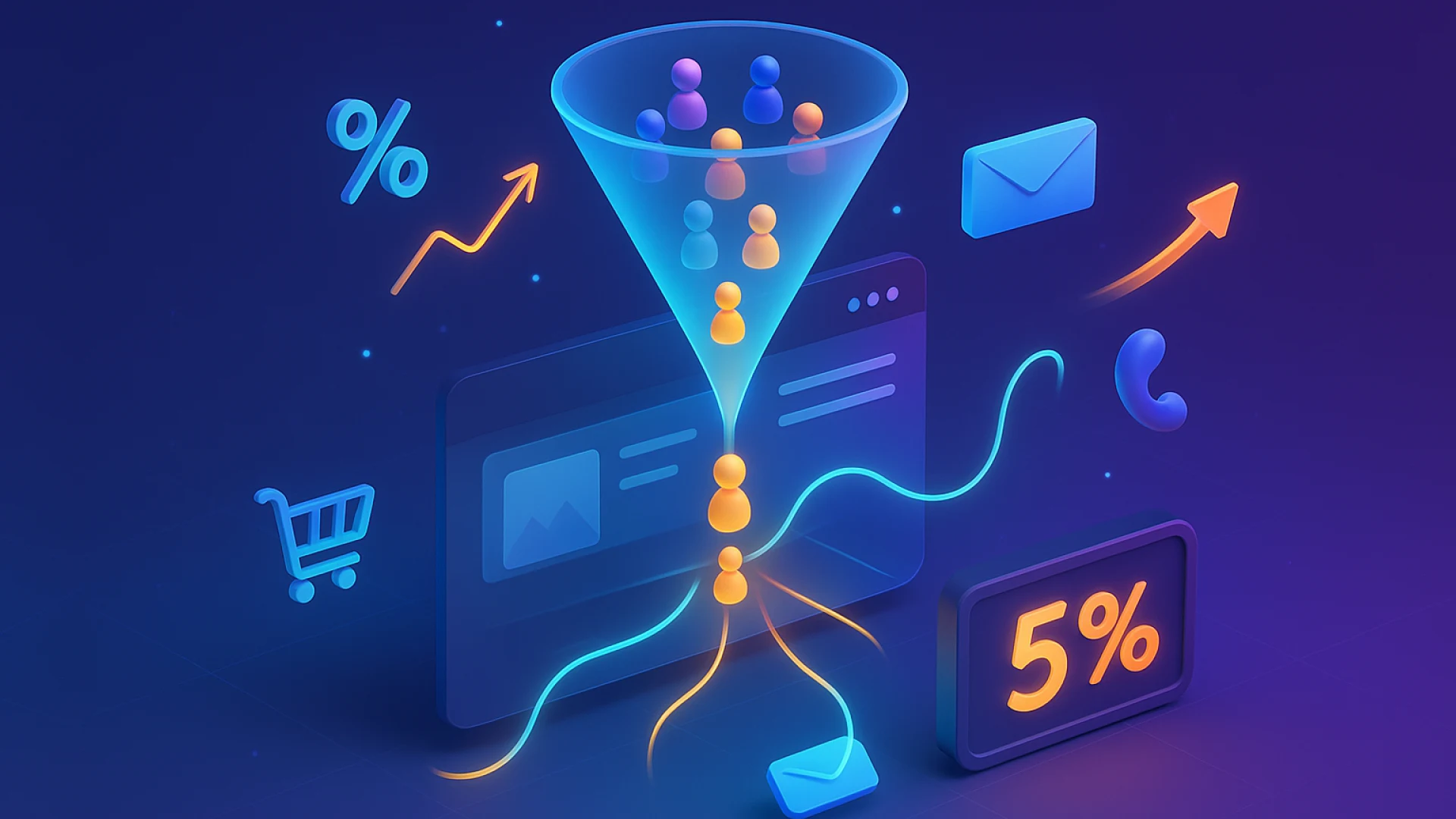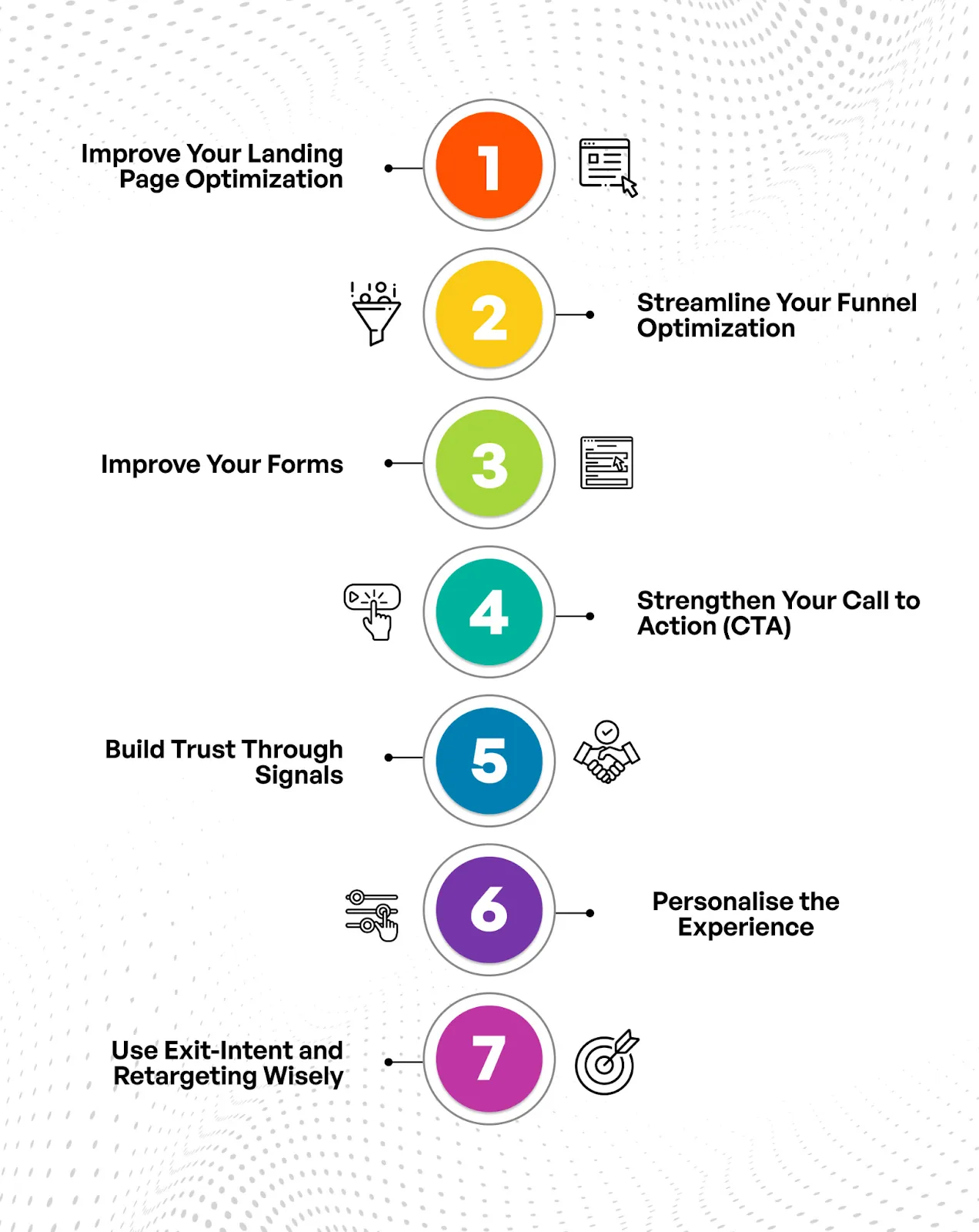TABLE OF CONTENTS
What is Conversion Rate Optimization?
Why CRO Matters More Than Just Getting Traffic
The Conversion Rate Optimization Process
- Data Collection
- Identify Drop-off Points
- Develop Hypotheses
- A/B Testing and Experimentation
- Measure Results and Refine
Key Conversion Rate Optimization Techniques and Strategies (CRO Best Practices)
- Improve Your Landing Page Optimization
- Streamline Your Funnel Optimization
- Improve Your Forms
- Strengthen Your Call to Action (CTA)
- Build Trust Through Signals
- Personalise the Experience
- Use Exit-Intent and Retargeting Wisely
Website Conversion Rate Benchmarks
General Conversion Rate Ranges
What is Conversion Rate Optimization? A Complete Guide to CRO
Every website has a goal. For some, it’s sales. For others, it’s lead generation, sign-ups, or downloads. Regardless of the objective, everyone wants the same thing: to get users to take action.
Every website has a goal. For some, it’s sales. For others, it’s lead generation, sign-ups, or downloads. Regardless of the objective, everyone wants the same thing: to get users to take action.
This brings us to the question: How exactly can you encourage users to take the necessary action?
Well, that’s where Conversion Rate Optimization (CRO) comes in. Rather than focusing purely on increasing traffic, CRO helps you maximize the traffic you already have by guiding visitors toward the actions that matter most to your business.
In this guide, we’ll answer the question “What is conversion rate optimization?” and explain why it matters, as well as how to improve website conversion rates without needing more traffic.
Let’s get right in.
What is Conversion Rate Optimization?

The word “conversion” simply refers to any action a business owner wants a user to complete. The conversion rate is calculated by dividing the number of conversions by the total number of visitors and multiplying by 100.
Example: If 200 users visit your product page and 10 make a purchase, the conversion rate is (10 / 200) × 100 = 5%.
According to the definition above, Conversion Rate Optimization (CRO) is the process of increasing the percentage of website visitors who take the desired action (such as making a purchase, signing up for a newsletter, clicking “add to cart,” or booking a call).
CRO focuses on understanding user behaviour, identifying barriers to action, and implementing changes that reduce friction and improve the user experience. The process is iterative, data-driven, and grounded in user psychology and behaviour, making it more important than just driving traffic.
Why CRO Matters More Than Just Getting Traffic
Increasing traffic without addressing the user journey often leads to diminishing returns. By improving conversion rates, you can extract more value from existing visitors, reduce customer acquisition costs, and boost return on investment (ROI).
Here’s the truth: for e-commerce and service-based businesses, even minor improvements in conversion rates can result in substantial revenue growth. For instance, raising a site’s conversion rate from 2% to 3% could translate to a 50% increase in sales, without any additional marketing spend.
Conversion rate optimization also plays a major role in:
- Improving user experience
- Reducing bounce rates
- Increasing customer trust
- Improving brand credibility
Now, let’s talk about the conversion rate optimization process and how you can implement it in your business.
The Conversion Rate Optimization Process
Improving your conversion rate isn’t about changing random elements on your website. It’s a structured, repeatable process that combines data, insight, and strategy to turn more of your traffic into results.

- Data Collection
Before making any changes, it is essential to understand how people interact with your website. This begins with collecting complex data using tools like:
- Google Analytics to view user paths, bounce rates, conversion funnels, and drop-off points
- Hotjar to generate heatmaps, scroll maps, and click maps. These visual insights reveal where users are paying attention and where they tend to drop off
- Session recordings to observe real-time clicks and hesitations
- Surveys or polls to ask visitors directly what they’re looking for or struggling with
- On-page feedback widgets to capture comments at critical moments (like form submissions or checkout pages)
With this analysis, you’re not just identifying “what” users do, you’re also learning “why.”
For instance, if users consistently abandon your sign-up form halfway through, a scroll map might reveal that they’re stopping at a particular field, possibly one that feels invasive or confusing.
- Identify Drop-off Points
Once you’ve collected the data, map out the conversion funnel from entry point to goal (e.g., homepage → product page → cart → checkout). Identify stages where users are leaking out of the funnel.
Ask questions like:
- Are users exiting right after reading the headline?
- Is the CTA too vague?
- Is there friction in the form fields?
- Are you asking for too much too soon?
For example, if your landing page gets good traffic but low conversions. A closer look might reveal that users are confused by the offer or that the CTA is buried too deeply on the page.
- Develop Hypotheses
Once you know where the problems lie, it’s time to propose fixes. A strong hypothesis combines insights from your data and a precise prediction.
Example Hypotheses:
- “If we reduce our form from 6 fields to 3, we’ll see more sign-ups.”
- “If we add customer testimonials above the fold, we’ll increase trust and reduce bounce rate.”
Your hypothesis should include the specific change, the expected outcome, and how you’ll measure success.
- A/B Testing and Experimentation
Now it’s time to test your ideas. The most common method is A/B testing, where you compare two versions of a page or element (A: the original, B: the variation).
To achieve this, we recommend using tools such as Optimizely and VWO.
Some important things to remember during this process are to:
- Only test one variable at a time for clarity
- Run the test long enough to get statistical significance
- Use a large enough sample size to draw valid conclusions
For instance, you can change the button text from "Submit" to "Get My Free Guide". Track if that improves your form conversion rate.
- Measure Results and Refine
After your test concludes, analyze the data:
- Did your variation outperform the control?
- Was the difference statistically significant?
- Were there any unexpected patterns?
If the test wins, then great, implement the change site-wide. If it doesn’t, go back to your hypothesis, learn from the result, and iterate.
Keep in mind that conversion rate optimization is not a one-time project. It is, however, a continuous cycle of learning and refinement. There’s no finish line, just better outcomes with every cycle.
Key Conversion Rate Optimization Techniques and Strategies (CRO Best Practices)
Once you understand how users behave on your site and have mapped out your conversion goals, the next step is to implement the proper techniques to help users take action more easily.

Here are some of the most effective strategies worth focusing on:
- Improve Your Landing Page Optimization
Your landing page is often the first real impression visitors have of your brand. It should immediately answer two questions for them:
- “Am I in the right place?”
- “What can I do here?”
To achieve this, use:
- A clear headline that communicates the main benefit or value
- Brief, persuasive copy that supports your headline without overwhelming the reader
- A single, focused CTA (call to action) that tells the visitor exactly what to do next
For instance, if you’re promoting a limited-time offer, your CTA might say “Claim My Discount” instead of a vague “Submit” button.
- Streamline Your Funnel Optimization
Your funnel includes every step a visitor takes between landing on your site and completing a goal. The more steps, distractions, or confusion points there are, the more likely users are to drop off or bounce.
Here are a few ways to tighten up your funnel:
- Simplify your checkout process (e.g., guest checkout, fewer form fields)
- Reduce page load times (especially on mobile)
- Make navigation intuitive, with minimal clicks to conversion
Think of it this way: every unnecessary step is an invitation to leave.
- Improve Your Forms
Long forms can quietly kill conversions. People don’t want to spend extra time filling in information they don’t feel is essential.
Here’s what you can do instead:
- Ask only for what you need. If it’s a newsletter signup, do you really need their phone number?
- Use multi-step forms for larger requests (e.g., onboarding or application processes), breaking them into bite-sized parts.
- Include progress bars so users can see how close they are to completing the task.
Tip: Label fields clearly and avoid using “submit” as your form button. “Get My Quote” or “Download Now” is far more effective.
- Strengthen Your Call to Action (CTA)
A strong CTA makes the next step feel natural and obvious. To improve yours:
- Use active, benefit-driven language. Instead of “Learn More,” say “See How It Works.”
- Make it visible. Use contrasting colors, larger font sizes, and whitespace to make the button stand out.
- Place it strategically (above the fold and at several decision points further down the page).
For instance, a fitness brand might use “Start My 7-Day Trial” instead of a flat “Sign Up.”
- Build Trust Through Signals
Users won’t convert if they don’t feel safe or confident. That’s where trust signals come in.
Include things like:
- Customer reviews and testimonials
- Security badges or SSL certifications at checkout
- Clear return policies or guarantees
- Press mentions or client logos (if relevant)
Trust removes doubt and reassures people they’re making the right choice.
- Personalise the Experience
Based on where someone came from (e.g., an ad, an email, a specific campaign), show them a message or offer that matches their intent.
Example: If a user clicks through from an ad about joint pain relief, the landing page should specifically reference joint care, not just general wellness.
Even simple things, like greeting a logged-in user by name or remembering what’s in their cart, can dramatically improve engagement.
- Use Exit-Intent and Retargeting Wisely
When someone’s about to leave your site, it doesn’t always mean they’re uninterested; they might just be undecided or distracted.
At this point, you can use exit-intent popups or retargeting ads:
- Offer a discount or bonus if they stay (“Wait! Here’s 10% off your first order”)
- Use retargeting ads to remind them of the product they viewed or abandoned
These tools work best when they’re respectful and relevant, not annoying and invasive.
Website Conversion Rate Benchmarks
So, what counts as a “good” conversion rate?
The truth is, there’s no universal number. Conversion rates vary significantly depending on your industry, the type of offer, your target audience, and even the device being used. However, having benchmarks can help you gauge your progress and identify areas where you can improve.
Let’s break it down.
General Conversion Rate Ranges
Here’s what most data shows across industries:
- Average ecommerce conversion rates tend to sit between 2.5% and 3%
- Service-based and lead generation sites often convert at 1% to 5%
- High-performing websites in both categories can hit 8% or more
Let’s say you run an online store and get 1,000 visitors a month; a 2% conversion rate means about 20 sales. If you improve that to 4%, that’s 40 sales, without increasing traffic at all.
That’s the good thing about CRO. Even small percentage gains can lead to significant revenue growth.
Now, What Affects Conversion Rate Benchmarks?
Several factors influence what’s considered a “good” conversion rate:
- Traffic source: Visitors from Google search often convert better than those from social ads or display networks. Why? They have intent, which means they’re actively looking.
- Device type: Desktop users generally convert at a higher rate than mobile users. But if your mobile site is well-optimised, that gap can shrink.
- Price point and complexity: A $25 product converts faster than a $2,500 service. The higher the cost, the more trust-building and education is required.
- Industry: Niche services may experience higher conversion rates due to targeted marketing, while broader markets (such as fashion or technology) may experience more fluctuation.
It’s important to note that while benchmarks are helpful, they shouldn’t be your priority. The real goal is to improve your conversion rate over time.
You can do this by:
1. Establishing your current baseline: Look at your current monthly traffic and conversion numbers. What’s your real-world percentage?
2. Set realistic growth goals: If you're currently converting at 1.8%, aim for a target of 2.5%. Then 3%. CRO is about steady improvement, not overnight miracles.
3. Segment your conversion data: Your homepage, product pages, blog, and checkout all serve different functions and should be evaluated separately.
Wrapping Up
If you’re working to reduce bounce rates, improve checkout completion, or get more leads from your existing traffic, conversion rate optimization can help you turn potential into performance, without spending more on ads or chasing more clicks.
If your website has traffic but conversions aren’t where they should be, we can help.
Book a free strategy call with the Pro Marketer team.
We’ll review your funnel and help you develop a plan to turn more visitors into customers consistently.
Frequently Asked Questions
Got questions? We got answers:
- What are some common mistakes to avoid in CRO?
Some of the biggest mistakes in Conversion Rate Optimisation happen when businesses skip the research and jump straight to changes. These include:
- Running tests without enough traffic or data
- Testing too many things at once (which makes it hard to know what worked)
- Ignoring mobile optimisation
- Making decisions based on gut feeling rather than user behavior
- Focusing only on aesthetics instead of user experience
CRO works best when it’s data-driven, user-focused, and iterative, not rushed or reactive.
- What is the average conversion rate for e-commerce sites?
Most e-commerce websites achieve conversion rates between 1.5% and 3%, depending on the product category, audience, and traffic source.
Top-performing stores can reach 5% or more, while niche or highly targeted offers may do even better.
- Can CRO help increase customer retention?
Yes. CRO can support retention by improving the overall user experience.
When a customer’s first experience with your site is smooth, intuitive, and satisfying, they’re more likely to come back. Clear value propositions, trust signals, and an easy checkout flow all contribute to stronger first impressions, which can influence repeat purchases later on.
- How long does it take to see results from CRO efforts?
It depends on your traffic volume, what you’re testing, and the significance of the changes. In general, you can expect to start seeing meaningful results from a well-designed A/B test within 2 to 4 weeks, long enough to gather statistically significant data.
For larger strategic shifts (such as funnel redesigns or landing page overhauls), it may take a few months to test, learn, and optimize.






.svg)

.avif)

.svg)